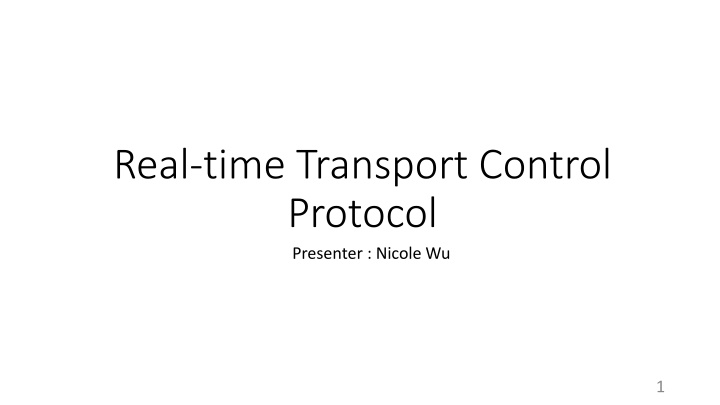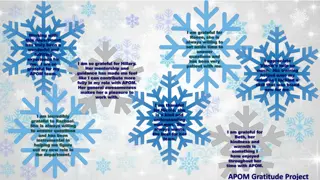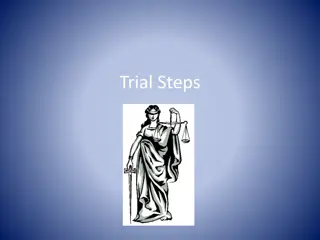
Real-time Transport Control Protocol (RTCP)
Explore the Real-time Transport Control Protocol (RTCP) and its role in monitoring transmission statistics, ensuring quality of service, and synchronizing multimedia streams. Learn about RTCP mechanics, message types, encapsulation, and more.
Download Presentation

Please find below an Image/Link to download the presentation.
The content on the website is provided AS IS for your information and personal use only. It may not be sold, licensed, or shared on other websites without obtaining consent from the author. If you encounter any issues during the download, it is possible that the publisher has removed the file from their server.
You are allowed to download the files provided on this website for personal or commercial use, subject to the condition that they are used lawfully. All files are the property of their respective owners.
The content on the website is provided AS IS for your information and personal use only. It may not be sold, licensed, or shared on other websites without obtaining consent from the author.
E N D
Presentation Transcript
Real-time Transport Control Protocol Presenter : Nicole Wu 1
Outline Outline Overview RTP RTCP Mechanics RTCP Message RTCP Sending Interval General principles Conclusion 2
Overview Overview PC Data(RTP multicast) Data(RTP multicast) QoS(RTCP) Multimedia device Network Data(RTP multicast) QoS(RTCP) PC Multimedia device QoS(RTCP) Multimedia device Real-time Transport Protocol (RTP) and Real-time Transport Control Protocol(RTCP) are transport protocol for real-time Applications RTP is a network protocol for delivering multimedia data over IP networks. RTCP is used to monitor transmission statistics and quality of service (QoS) and aids synchronization of multiple streams 3
Overview Overview ----Multimedia Protocol Stack 4
RTP Sequence number The sequence number increments by one for each RTP data packet sent. Timestamp The timestamp reflects the sampling instant of the first octet in the RTP data packet . SSRC The SSRC field identifies the synchronization source. 5
RTCP Mechanics RTCP Mechanics RTCP messages are stackable . compound RTCP message RTCP messages are always sent in (at least) pairs. RTCP messages are sent periodically with a period set to ensure that control messages consume no more than 5% of the session bandwidth. 6
RTCP Message types RTCP Message types Sender reports (SR),type:200 cumulative frame & byte counts wall clock/timestamp values Receiver reports (RR), type:201 frame loss/Frame delivery rate Source description (SDES) , type:202 useful ASCII text strings (user & host name of participant) BYE, type:203 used to update participant s SSRC tables 7
RTCP Message encapsulation IP Header UDP Header RTCP header IP Packet SR/RR UCP Reception Report Blocks RTCP Datagram compound message RTCP header SDES/BYE Item(ex:CName ) 6
The RTCP sender/receiver report The RTCP sender/receiver report message ----Reception report blocks message source identifier fraction of RTP packets from this source lost since the last report cumulative number of lost packets extended highest sequence number received estimated average RTP packet interarrival time jitter last SR timestamp received from this source delay since receiving the last SR report from this source 13
RTCP Reception Report Blocks RTCP Reception Report Blocks ----Loss calculation Sent RTCP message Sent SR Sender Receiver Sent RR The time that RTCP calculate the lost packet number of packets lost number of packets expected fraction lost 15
RTCP Reception Report Blocks RTCP Reception Report Blocks ----Jitter calculation Sent RTP packet jitternew = jitterold +( instantaneous jitter jitterold )/16 instantaneous jitter = (reci rec(i 1)) (senti sent(i 1)) 16
RTCP Reception Report Blocks RTCP Reception Report Blocks ----Round trip time calculation Sent RTCP message sent SR rec RR estimated round-trip- time = RR received SR sent delay RR received = time a source received this reception report SR sent = last SR timestamp received field delay = delay since last SR report field 17
RTCP RTCP Sending Interval General principles Sending Interval General principles Generic RTCP transmission guidelines: RTCP messages should consume no more than 5% of session bandwidth 25% of RTCP bandwidth should be allocated to senders 18
Conclusion Conclusion RTP is a network protocol for delivering multimedia data over IP networks. RTCP is used to monitor transmission statistics and quality of service (QoS). A network management tool may monitor the network load based on the RTCP packets without receiving the actual data or detect the faulty parts of the network 19
Q&A 20
Reference Reference RFC3550 RTCP Report http://reeves.csc.ncsu.edu/Classes/csc573/rtp-rtcp.pdf http://140.116.72.245/~ruready566/RTP_RTCP.pdf http://netlab.csie.ntut.edu.tw/seminar/year2010/CKC20101224.pdf http://www.cs.odu.edu/~cs778/jeffay/Lecture6.pdf The Research and Implementation of voip multimedia system 21






















